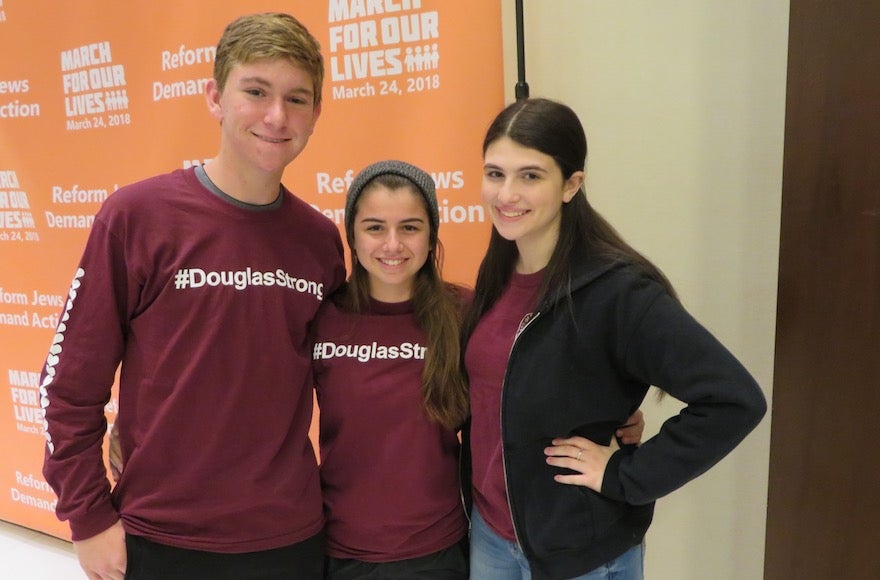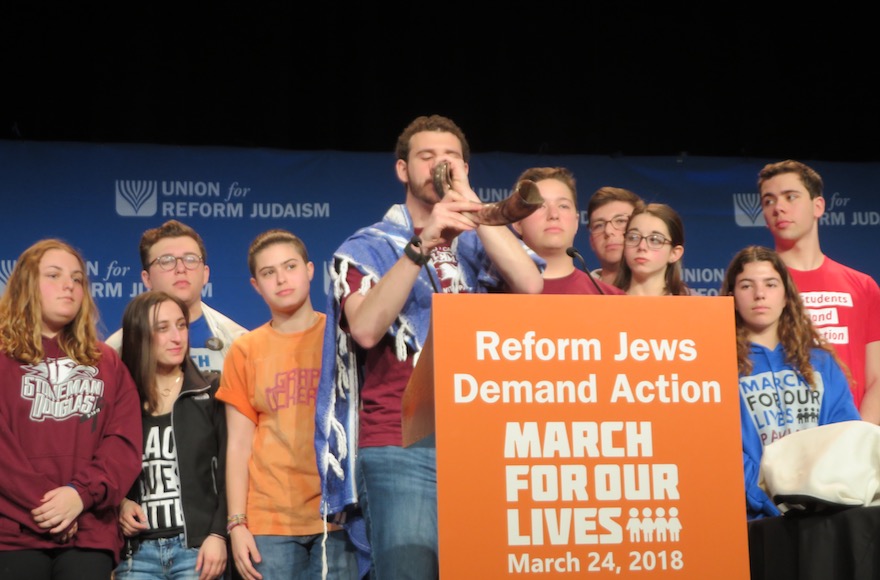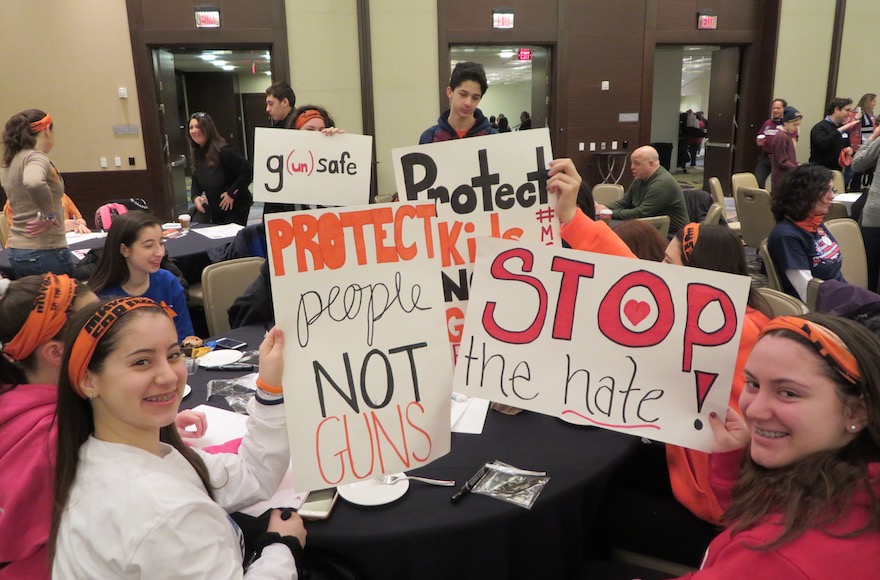‘We march today because it’s what we have to do to sleep tonight:’ Jewish students on the March For Our Lives
Published March 24, 2018

From left to right: Charlie Goodman, 15, Kayla Renert, 15, and Talia Rumsky, 16, survivors of the Feb. 14 shooting at Marjory Stoneman Douglas High School in Parkland, Fla., posing at a NFTY event in Washington D.C. before the March for Our Lives march against gun violence, March 24, 2018. (Ron Kampeas)
WASHINGTON (JTA) — The organizers of the March for our Lives, not one of them over 20, had a gun control agenda packed with specifics. They were able to get 800,000 people on and off of Washington D.C.’s Pennsylvania Avenue in three hours. They attracted A-list celebrities.
ADVERTISEMENT
But in the end, the event was most riveting when a survivor relived one more time, for a reporter, for a shul full of worshippers, for millions watching around the world, what they felt when Nikolas Cruz entered the Marjory Stoneman Douglas High School in Parkland, Florida and opened fire.
A highlight came when Parkland student Emma Gonzalez, who has emerged as a leader among the students, named 17 students and teachers who died in the Feb. 14 shooting, in a recitation that took just under two minutes.
She remained silent for another four minutes and twenty-five seconds, and then an alarm went off. In total, she took six minutes and twenty seconds — exactly the time it took for a gunman to change hundreds of lives forever.
“Everyone who has been touched by the cold grip of gun violence understands,” she said.
Marchers came from around the country, among them at least 2,500 Jewish teenagers coming from as far afield as California, Colorado and Minnesota. They threw sleeping bags on the floors of local temples and Jewish community centers, under the aegis of the Reform movement’s North American Federation of Temple Youth (or NFTY).
ADVERTISEMENT
It took 21 hours for 75 teens to bus in from Minneapolis-St. Paul. They turned up outfitted in T-shirts that were colored orange for gun control and read #Dayenu — or, “it would have been enough” in Hebrew.
At an event in a ballroom deep in the bowels of Washington’s Marriott Marquis hotel in the hours before the march, the NFTY leadership — as with the wider demonstration, the Jewish presence was organized by teenagers — gave them permission to vent.
“We march today because it’s what we have to do to sleep tonight,” said Zoe Terner, the social action vice president for NFTY-Southern Tropical Region. “This is how we grieve.”
Five of the 17 killed were Jewish and the school is estimated to be 40 percent Jewish. Terner, 18, attends high school in nearby Delray Beach and has made friends from Stoneman Douglas through the movement.

A NFTY activist blowing a shofar before the March for Our Lives march against gun violence in Washington D.C., March 24, 2018. (Ron Kampeas)
The night before, at a Shabbat service at Washington Hebrew congregation in Washington D.C.’s Northwest quadrant, Terner pledged: “Tomorrow I will pray with my feet, and with every step, I will think of those few hours a month ago when I didn’t know if my friends were alive or dead.”
And so they grieved, by telling their stories: “I will not stand idly by the blood of my classmates,” Zoe Fox-Snider told the marchers gathered in the hotel ballroom Saturday morning, paraphrasing Leviticus 19:16, “after spending two and a half hours fearing for my life in the storage room of the media center.” The evening before at Washington Hebrew, she told congregants about her thoughts in the storeroom: “I was forced to text my mom, ‘I love you and everyone. This is real.’”
At a media opportunity organized by NFTY, Stoneman Douglas students Talia Rumsky, 16, Charlie Goodman, 15 and Kayla Renert, 15 started a speech by talking about the Jewish values that brought them to the march. But Renert soon lapsed into remembering the day, and the others started talking over her.
“We had to run past the middle school –,” Renert said.
“We saw the SWAT team –,” said Rumsky.
“We heard the gunshots –,” Renert said.
“My sister Sophie was in the middle school,” said Goodman. “I had no idea what was going on.”
They slowed down and got back to what brought them to Washington.
“Those people we lost on that day, that’s who we’re here for,” said Rumsky.
“It hit home so hard,” said Renert.
“We have a lot of nervous energy,” Goodman said. “We’re using this as an outlet.”
Rumsky later drew a placrad reading, “NRA, stop killing my friends.”
Marlee Gordon, a camp counselor at Camp Coleman, the Union for Reform Judaism camp in Georgia attended by a number of Douglas high school students, immediately thought of a fellow student at the University of Georgia when she heard from friends the day of the shooting that Alyssa Alhadeff was among the missing and presumed dead. Her friend, also a Camp Coleman counselor, had Alhadeff was among his charges last summer. She called up another two Coleman counselors who were on the Athens, Georgia university campus, and headed to her friend’s apartment to keep him company.
“He refused to believe she had died,” recalled Gordon, 19, as she helped friends paint placards at a breakfast table. “We stayed with him all night, waiting for Alyssa’s name to be said on the news, so we would be there.”
The disciplined message, in lobbying lawmakers on Friday, at the NFTY event on Saturday and reiterated again and again by the speakers at the main event on Pennsylvania Avenue was multi-pronged. It called for a ban on the purchase and sale of assault weapons, on the sale of high-capacity magazines, the institution of universal background checks for gun purchasers, ending background check exemptions for purchases online and at gun shows.
There was plenty of glitz at the march itself, including performances by Broadway stars Lin Manuel Miranda and Ben Platt, by rapper Common and by pop stars Miley Cyrus and Ariana Grande. (The survivors on stage, who sounded so wizened, became kids again when Grande finished singing “Be Alright,” rushing her for selfies, which she accommodated with a grin.)
There was an acutely self-aware sense of why they were able to attract that starpower. “Gun violence disproportionately affects people of color,” said Rachel Berlowe Binder, a Duke University student speaking at the NFTY event. “The death rate from gun violence is ten times higher than among white children.”

Rebecca Waldman, 14, on left, from Freehold, N.J., and Lindsey Jacobs, 13, on right, of Manalapan, N.J., posing with placards they prepared for the March for Our Lives march against gun violence in Washington, D.C., March 24, 2018. (Ron Kampeas)
One of the speeches that drew the loudest cheers was by Naomi Wadler, 11, from Alexandria, Virginia. “I am here today to acknowledge and represent the African-American girls whose stories don’t make the front page of every national newspaper,” said Wadler, who is African American and Jewish. “I represent the African-American women who are victims of violence, who are simply statistics instead of vibrant, beautiful girls who are full of potential.”
There were the moments of faith. Marchers spilled out of churches along Pennsylvania Avenue. Edna Chavez, who lost her brother to gun violence in south Los Angeles, crossed herself as she walked on stage. Some Jewish marchers had signs emblazoned with words from Leviticus 16:19: “Do not stand idly by while your neighbor’s blood is shed.” (Not all the signs were so reverential. “ALTE KAHKERS STAND WITH OUR CHILDREN,” read one placard.)
A service Friday night at the National Cathedral began with the Washington Children’s Choir singing Al Shlosha Dvarim, about the pillars of faith. Rabbi Jonah Pesner, the director of the Reform’s Religious Action Center, delivered a sermon based on Yom Kippur’s Al Cheit, for the sins we have committed.
“Al Chet Shechatanu Lifanchea – for being understandably outraged by a mass shooting in an affluent, majority white community, and being all too silent when children of color are murdered every day,” he said.
And there were moments of catharsis. Aaliyah Eastmond and Samantha Fuentes described the terror they felt in a Stoneman Douglas class on Holocaust studies when the gunman burst in. Fuentes said she wanted a world where “you don’t have to worry about going into a Holocaust history class to learn about death, and the experience it before your eyes.” Two students, Nicholas Dworet and Helena Ramsey were killed in the attack. Fuentes was so overcome with emotion describing the day, she threw up — and then completed her speech, with encouragement from the crowd.













